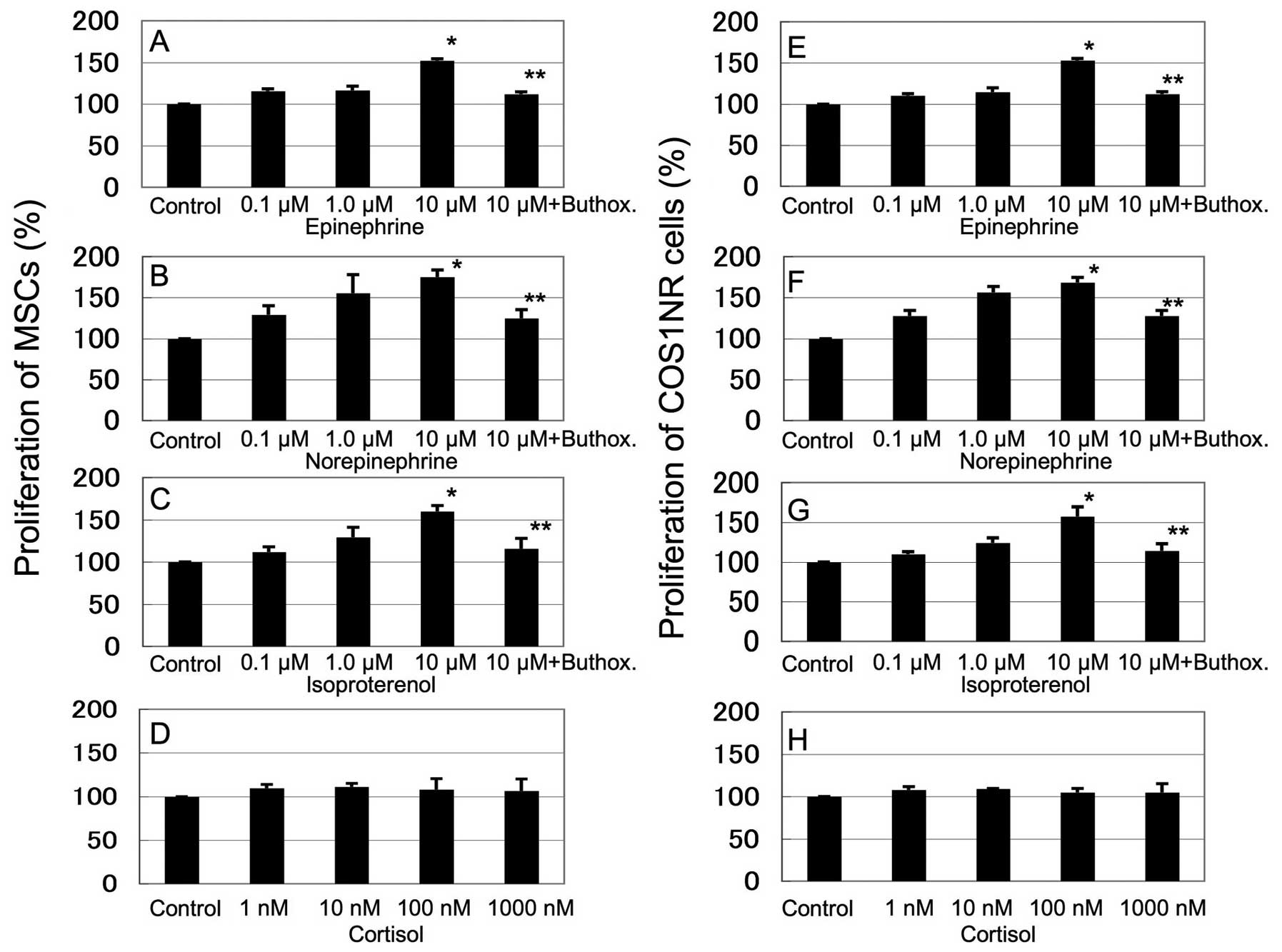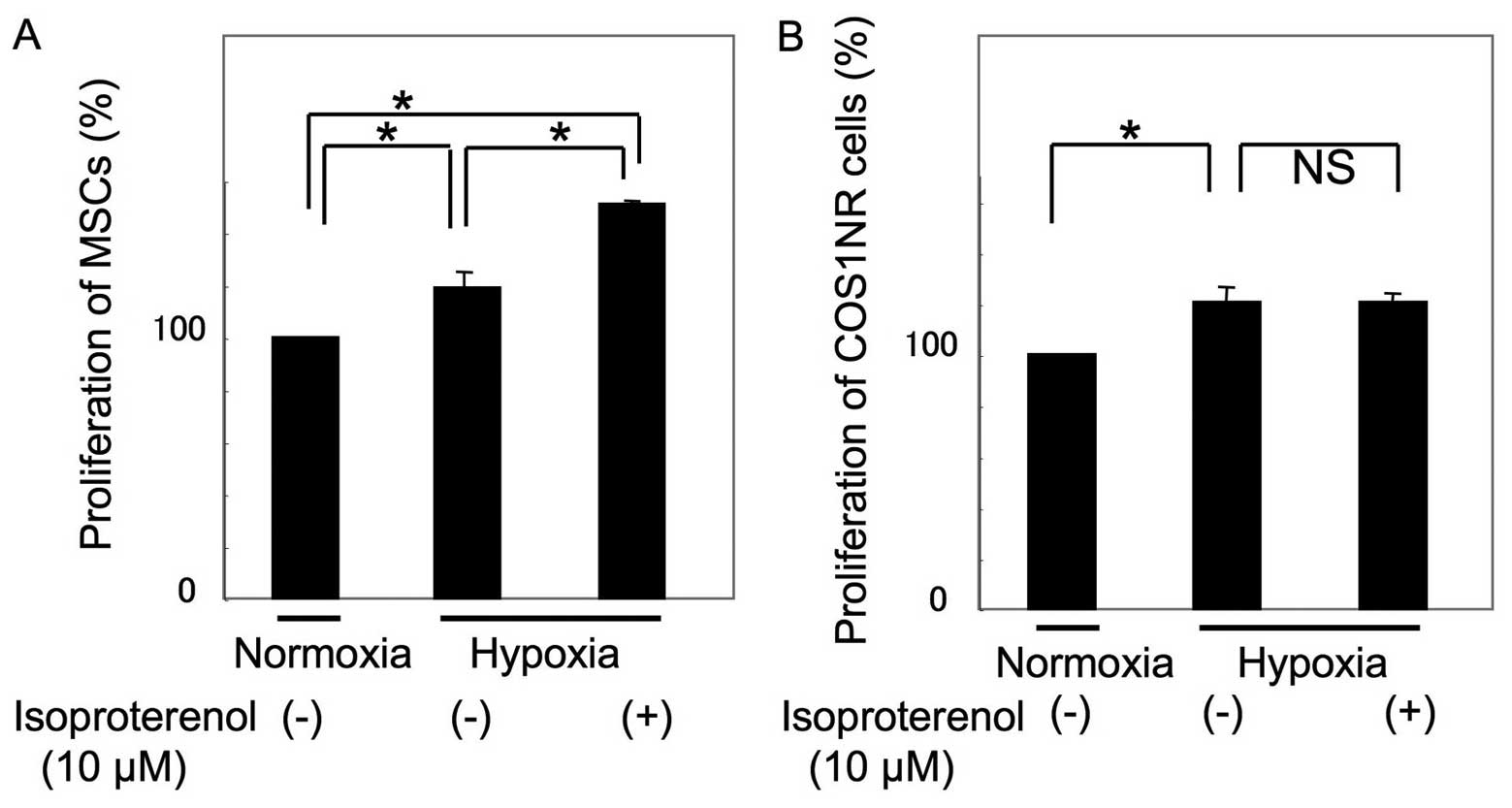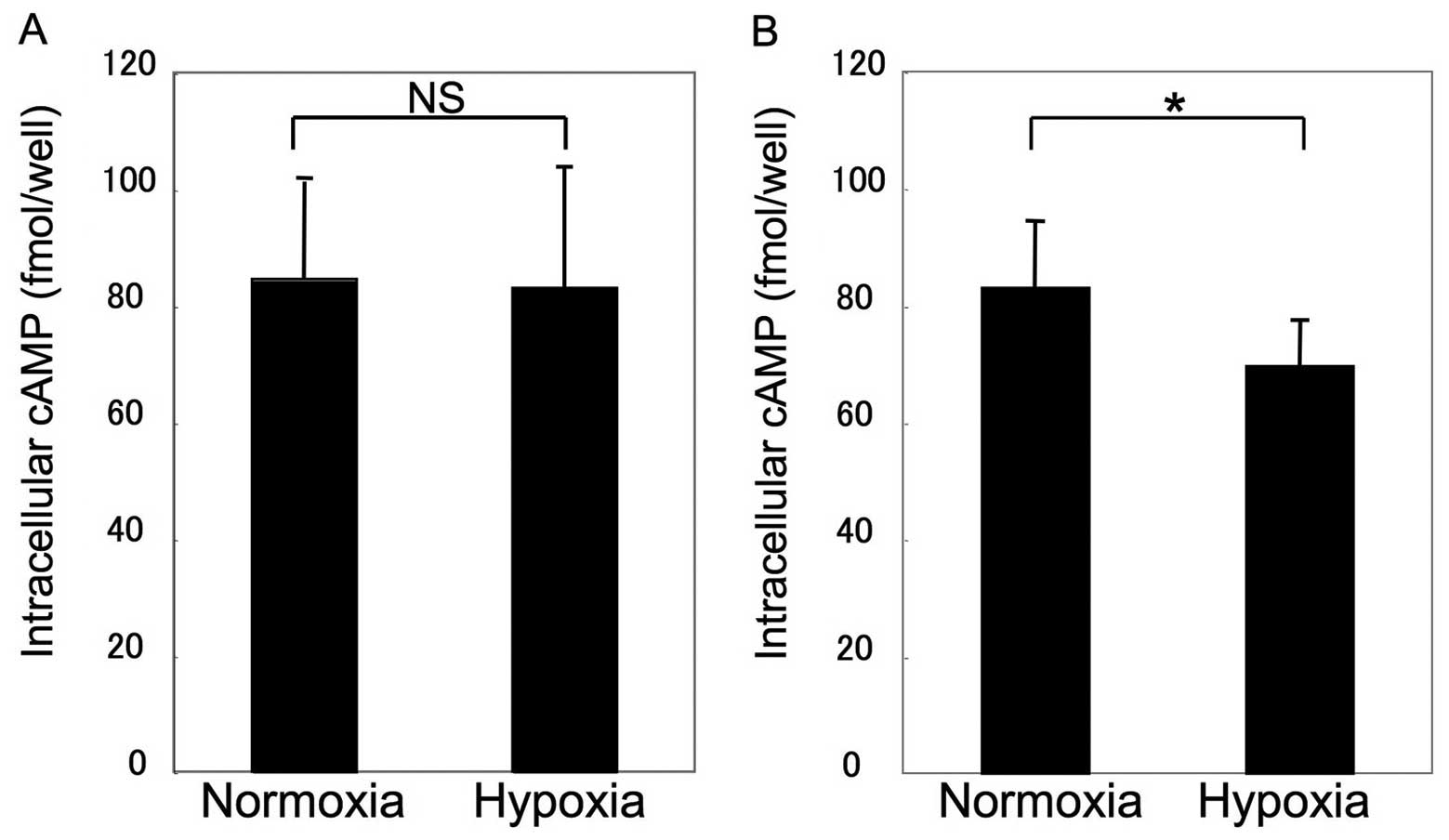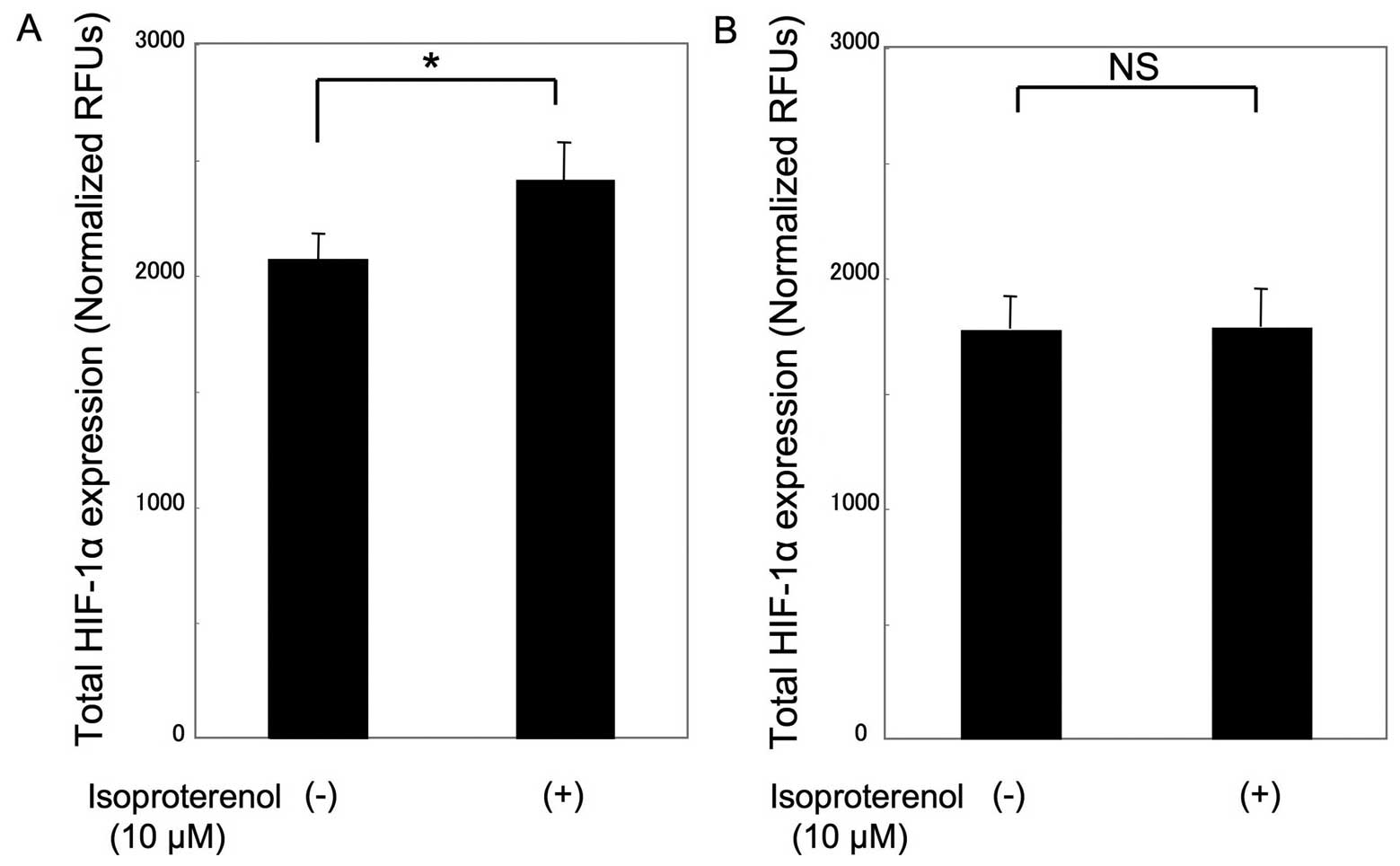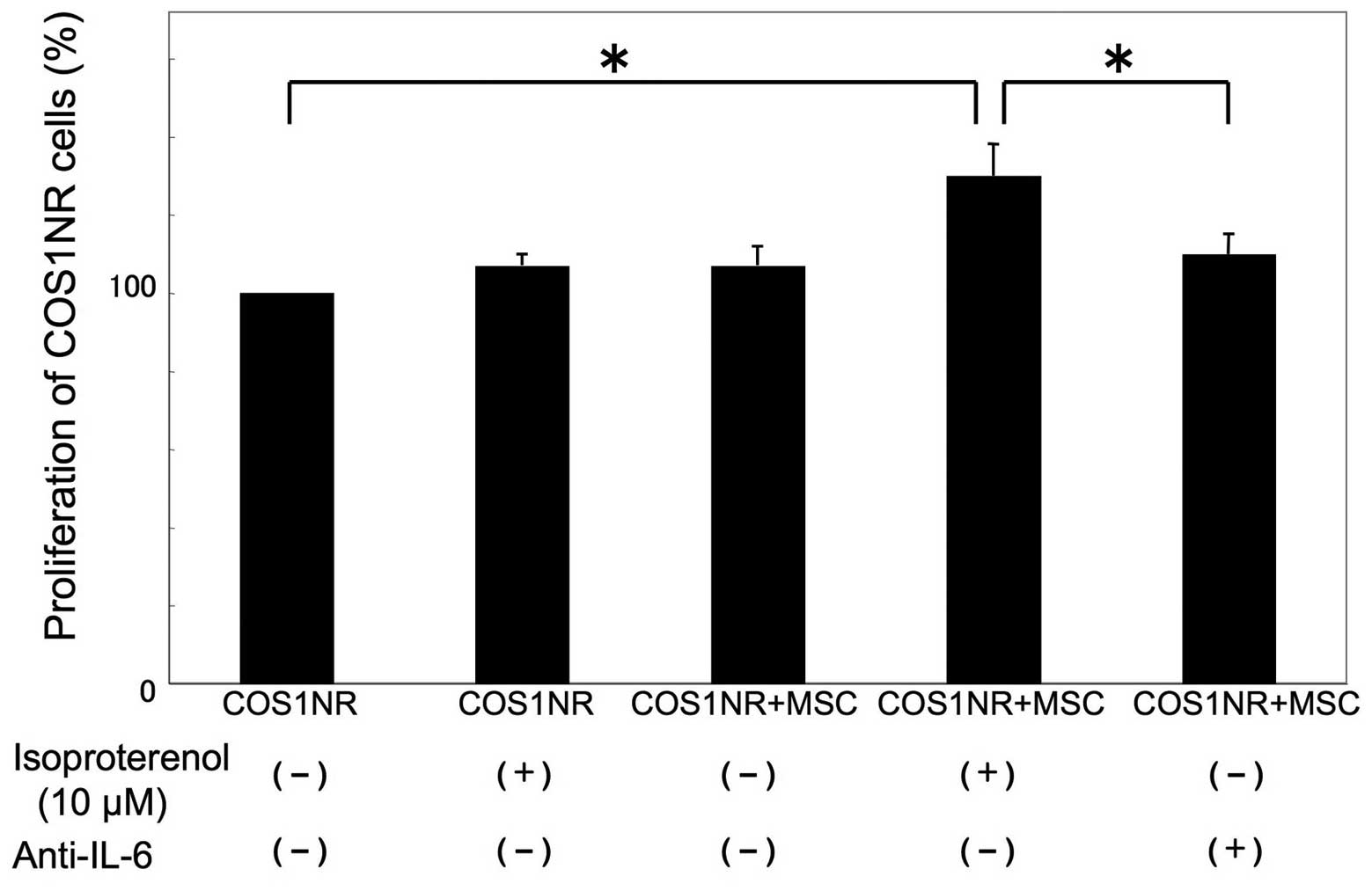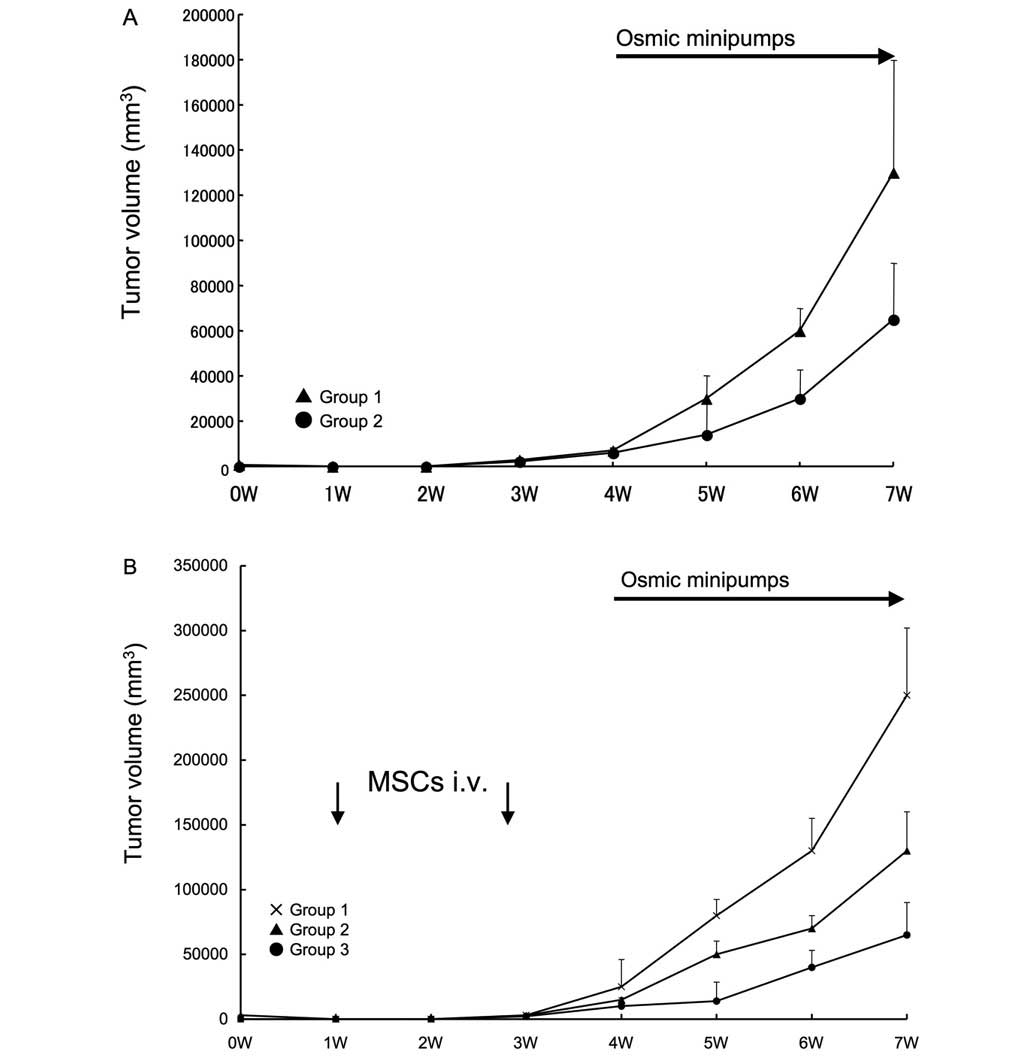Effect of mesenchymal stem cells on hypoxia‑induced desensitization of β2-adrenergic receptors in rat osteosarcoma cells
- Authors:
- Published online on: July 19, 2012 https://doi.org/10.3892/ol.2012.813
- Pages: 745-750
Abstract
Introduction
Solid tumors are composed of a heterogeneous cell population, including a variety of tumor stromal cells. These cells create the tumor microenvironment, which is significant in tumor progression, through cellular interactions (1). Mesenchymal stem cells (MSCs) are bone marrow-derived multipotent cells, that are capable of differentiating into a variety of tissues, including fat, cartilage, bone and possibly muscle (2). Being part of the tumor microenvironment, MSCs are considered to create niches and facilitate tumor growth and metastasis (2). We have previously reported that MSCs promoted engraftment and metastatic colonization in a rat osteosarcoma (OS) model (3). Pathway analysis from a gene expression profile identified that the genes involved in adhesion, cytokinecytokine receptors and extracellular matrix pathways were highly expressed in the MSCs (3). In accordance with our data, Bian et al have previously reported a critical role of interleukin (IL)-6 in the interaction between OS cells and MSCs (4).
β2-adrenergic receptors (β2ARs) mediate osteogenesis (5). β2AR signaling induces c-fos gene expression in OS cell lines (5), modulates bone turn-over in osteoblasts (6) and affects the osteogenesis of MSCs via the cyclic AMP (cAMP)/PKA pathway (7). In addition, β2AR activation leads to the upregulation of hypoxia-inducible factor-1α (HIF-1α) via Akt and ERK1/2 signaling (8), that may be a mechanism by which β2AR signaling accelerates tumor growth in several types of cancer (9–13). Conversely, hypoxia impairs β2AR signaling in a variety of tissues (14–16). Baloğlu et al demonstrated that in vitro hypoxia increased the sensitivity of β2AR to desensitization, owing to an increase in Gi/0 protein activity (14). Although hypoxia is a common feature significant in the progression of solid tumors, little is known about the effect of β2AR signaling in the tumor microenvironment.
The present study investigated the effect of hypoxia on β2AR signaling in OS cells and MSCs derived from the bone marrow of syngeneic rats. Cellular interactions were examined using in vitro and in vivo approaches. Co-culture experiments revealed that hypoxia caused significant desensitization of β2AR on OS cells but not MSCs and that MSCs affected the response of OS cells to β2AR agonists. Systemic administration of MSCs resulted in the enhanced growth of subcutaneously transplanted OS in response to β2AR agonists.
Materials and methods
Cell lines
The COS1NR cell line was established from 4-(hydroxyamino)-quinoline 1-oxide-induced transplantable OS in male Fischer 344 (F344) rats (17,18). The cells were cultured in Eagle’s Modified Essential Medium (MEM) supplemented with 10% FBS (JRH Biosciences, Lot no. 1E0666, Lenexa, KS, USA). Rat MSCs were isolated and maintained in primary culture as previously described (19,20). Briefly, bone marrow cells were obtained from the femoral bone shaft of 7-week-old male F344 rats and seeded into 75 cm2 flasks (T-75 flasks, Corning Costar, Cambridge, MA, USA) containing 15 ml of standard medium consisting of MEM supplemented with 15% FBS and a mixture of antibiotics (100 U/ml penicillin and 100 μg/ml streptomycin; Sigma-Aldrich, St. Louis, MO, USA). Cell cultures were maintained in a humidified atmosphere of 95% air and 5% CO2 at 37°C. After reaching confluency (∼10 days), the cells were released from the substratum using a 0.25% trypsin-EDTA solution and inoculated into 12- and 6-well plates (Falcon, Franklin Lakes, NJ, USA) for biochemical analyses and staining, respectively, at a density of 1×104 cells/cm2.
Gene expression profiling of COS1NR and MSCs
The gene expression profiling was performed by Agilent array analysis (Agilent Technologies, Böblingen, Germany). Total RNA was isolated from COS1NR cells and MSCs and underwent a quality assessment by Agilent 2100 Bioanalyzer. Total RNA (500 ng) was processed by Agilent expression array analysis using a Quick Amp Labeling kit and Gene Expression Hybridization kit. Data analysis was carried out using Agilent Feature Extraction software, analyzing pathways that possibly interact in OS cells and MSCs.
Hypoxic conditions
For hypoxic stimulation, the culture plates were placed in a MCO-175M multi-gas incubator (Sanyo Electric Co., Ltd., Tokyo, Japan) at 37°C and flushed with a gas mixture of 5% CO2/95% N2. The oxygen concentration was maintained at 2% in the chamber using an oxygen regulator (Sanyo Electric Co., Ltd.).
Cell viability assessment
Cell viability was assessed using the 3-(4,5-dimethylthiazol-2-yl)-5-(3-carboxymethoxyphenyl)-2-(4-sulfophenyl)-2H-tetrazolium (MTS) assay. A single-cell suspension was plated in 96-well plates at 2.0×103 cells/well and allowed to attach to the plates at 37°C for 4 h. The cells were then cultured for 48 h under hypoxic or normoxic conditions. The cells were left either untreated or treated with neurotransmitters for 10 min, 8 h after the start of culture. Cell viability was measured using the Cell Titer 96 Aqueous One Solution Cell Proliferation Assay Reagent (Promega Corp., Madison, WI, USA). Cell proliferation was measured at an emission wavelength of 492 nm. All experiments were carried out in quadruplicate and viability was expressed as the ratio of the number of viable cells with treatment to the number of viable cells without treatment.
cAMP enzyme immunoassay (EIA) and total HIF-1α protein quantification
β2AR sensitivity was determined using a cAMP EIA kit (Item no. 581001, Cayman Chemical Company, Ann Arbor, MI, USA), according to the manufacturer’s instructions. Total HIF-1α protein quantification was performed using the human/mouse total HIF-1α immunoassay kit (Item no. KCB1935, R&D Systems, Minneapolis, MN, USA) according to the manufacturer’s instructions. Cells were cultured in 12-well plates for cAMP measurements and in 96-well plates for HIF-1α protein quantification. Seeding density was 200,000–300,000 cells/cm2. Confluent cells were exposed to hypoxia for 48 h. Following 8 h of hypoxia, the cells were treated with 10 μM of isoproterenol for 10 min. Following 48 h of hypoxia, cell culture extracts and formaldehyde-fixed cells were used for the cAMP assay and HIF-1α immunoassay, respectively.
Co-culture experiment
The co-culture of COS1NR cells and MSCs was performed using a 6-well format cell culture insert with a 1.0-μm pore size polyethylene terephthalate track-etched membrane (Becton-Dickinson, Franklin Lakes, NJ, USA) in 6-well flat-bottomed multi-well tissue culture plates. MSCs were placed in the upper chambers. The number of cells and the volume of culture medium in the dividing chamber culture were identical to those in the control. Co-cultured cells were subjected to the same treatment as the isolated culture described above. For the neutralization of IL-6 in bioassays, cells were cultured with a 1:400 dilution of an IL-6 antibody for 3 days (ab6672, Abcam, Cambridge, UK).
In vivo tumor formation assay in syngeneic rats Experiment I
Cells (5×106) of COS1NR in 100 μl of phosphate-buffered saline (PBS) were inoculated into the subcutaneous tissue in the posteriors of F344 rats (groups 1 and 2). Each group consisted of 4 rats and the growth rate of the tumor was evaluated every week. The size of the tumors was calculated using the formula volume = 0.2618 x L x W x (L + W) (21). For β2AR stimulation, the Alzet osmotic minipumps were inserted (DURECT Corporation, Cupertino, CA, USA) containing isoprotelenol (3 mg/kg/day, group 1) or PBS (group 2) in the nape of the neck at week 4. At week 7, the rats were sacrificed and samples from subcutaneous tumors in each group were fixed in 3.7% formaldehyde neutral-buffered solution and then processed routinely for histology, stained with hematoxylin-eosin and examined under light microscopy. On the day of minipump implantation, intratumoral oxygen pressure was measured using the needle probe technique (KIMOC-6650, Eppendorf, Germany). The measurement was performed in quadruplicate at a depth of 5 mm from the tumor surface.
Experiment II
cells (5×106) of COS1NR in 100 μl of PBS were inoculated into the subcutaneous tissue in the posteriors of F344 rats. Subsequently, the same number of MSCs in 100 μl of PBS were directly injected into the circulation through the tail vein twice at weeks 1 and 3 (groups 1 and 2). In group 2, the injected MSCs were neutralized with anti-IL-6 antibodies as described above. Each group consisted of 4 rats. The growth rate of the tumors was evaluated every week and compared with that of the control group without the injection of MSCs (group 3). For β2AR stimulation, the Alzet osmotic minipumps containing isoprotelenol (3 mg/kg/day, all groups) were inserted in the nape of neck at week 4. The growth rate was evaluated as described above. Samples from subcutaneous tumors in each group were fixed in 3.7% formal-dehyde neutral-buffered solution and then processed routinely for histology, stained with hematoxylin-eosin and examined under light microscopy.
Statistical analysis
Statistical analyses of cellular proliferation, intracellular cAMP and total HIF-1α expression were performed with Student’s t-tests using Stata 8 (StataCorp, College City Station, TX, USA).
Results
Effect of stress-related neurotransmitters/hormones on COS1NR cells and MSCs
Fig. 1 shows the in vitro response of COS1NR cells and MSCs treated with epinephrine (0.1–10 μM), norepinephrine (0.1–10 μM), isoproterenol (0.1–10 μM) and cortisol (1–1000 nM). Stimulation with epinephrine, norepinephrine or isoproterenol increased the cellular proliferation in a dose-dependent manner. Treatment with 10 μM epinephrine, norepinephrine or isoproterenol resulted in significantly increased proliferation in MSCs (136±3.9, 152±8.8 and 133±4.9% of the control, respectively, P<0.05) and in COS1NR cells (131±9.1, 150±4.2 and 138±7.7% of the control, respectively, P<0.05, Fig. 1A–C, E–G). These effects were significantly inhibited by 100 μM buthoxamine, a β2AR-selective inhibitor (P<0.05, Fig. 1A–C, E–G). Cortisol did not affect cellular proliferation significantly. These results suggest that β2AR signaling mediates the response to stress-related hormones and neurotransmitters in the OS microenvironment (Fig. 1D and H).
Effect of hypoxic stimulation on COS1NR cells and MSCs
The cellular proliferation of COS1NR cells and MSCs under hypoxic conditions was then examined. Following 48 h of culturing under 2% O2 conditions, proliferation increased to 118±7.8% in MSCs and 121±6.3% in COS1NR cells, compared with the normoxic control (P<0.05, Fig. 2). Under hypoxic conditions, MSCs treated with 10 μM isoproterenol demonstrated an increase in proliferation to 127±2.1% of the hypoxic control (P<0.05), whereas COS1NR cells demonstrated no significant effect, suggesting that β2AR signaling-induced proliferation is impaired by hypoxic stimulation in COS1NR cells.
β2AR sensitivity and HIF-1α expression
Assays for β2AR sensitivity and HIF-1α expression were performed to clarify the mechanism of impairment. Fig. 3 shows that β2AR sensitivity was unchanged in MSCs under hypoxic conditions, whereas β2AR sensitivity demonstrated a significant decrease to 78±11.5% of the control in COS1NR cells (P<0.05). Consistent with this observation, HIF-1α expression in isoproterenol-treated MSCs was 115±8.3% of the expression in the untreated control cells under hypoxic conditions (P<0.05), whereas there was no significant change in isoproterenol-treated COS1NR cells (Fig. 4).
Co-culture of COS1NR cells and MSCs under hypoxic conditions
To examine whether MSCs may affect the in vitro response of COS1NR cells, a co-culture experiment was performed. Co-cultured cells were treated with 10 μM isoproterenol under hypoxic conditions for 48 h as described previously. In the presence of co-cultured MSCs, COS1NR cells demonstrated a significant increase in cellular proliferation following isoproterenol treatment (131±8.5%, P<0.05). Based on our gene profiling assay (Table I), IL-6 was then neutralized in co-culture medium. The neutralization of IL-6 significantly inhibited the effect of co-cultured MSCs (P<0.05, Fig. 5).
Effect of intravenous injection of MSCs on tumor growth in syngeneic rats
Subsequently, an in vivo tumor formation assay in syngeneic rats was performed. An hypoxic condition was confirmed in the rat model, with a tumoral oxygen pressure of 14±2.5 mmHg. No significant inter-group variation was revealed. Rats receiving isoprotelenol exhibited increased growth of tumors (Fig. 6A), however, the systemic administration of MSCs enhanced the growth of tumors in response to isoproterenol injection (Fig. 6B). Notably, this effect was inhibited by the IL-6 neutralization of MSCs prior to administration.
Discussion
Neurotransmitters are significant in cancer progression (22). Immune cells are involved in the hypothalamic-pituitary-adrenal axis and the sympathetic nervous system, through their expression of receptors for glucocorticoids and catecholamines, respectively (22). In addition, the direct effects of stress-related neurotransmitters have been reported in various types of cancer through β2AR signaling (9–13). However, under hypoxic conditions in vitro, β2AR signaling does not appear to simply be a facilitator of cancer expansion. Baloğlu et al (14) reported that hypoxia caused the desensitization of the β2AR, owing to an increase in Gi/0 protein activity, or possibly, heterologous receptor desensitization by the activation of other receptors. The authors suggested that the effects are likely to depend on tissue type as well as the degree and duration of hypoxia (14).
The current study focused on the hypoxia-induced desensitization of β2AR on OS cells. It was observed that the sensitivity of COS1NR cells was significantly decreased under hypoxia, while that of MSCs was not. HIF-1α expression was unchanged in COS1NR cells while expression increased in MSCs. These observations may explain why the cellular proliferation of COS1NR cells was not increased by β2AR stimulation under hypoxia. In terms of cancer growth, this desensitization would be unprofitable for the neoplasms themselves, however, IL-6 stimulation by MSCs may compensate for this. In the present in vivo experiment, the systemic administration of MSCs resulted in increased tumor growth, while native MSCs were also recruited to tumors.
The correlation between OS- and bone marrow-derived MSCs remains uncertain. Mohseny et al (23) reported that OS originates from MSCs as a consequence of aneuploidization and the genomic loss of cyclin-dependent kinase inhibitor 2, which suggests an obstacle to the clinical use of MSCs. Shimizu et al (24) reported that the overexpression of c-myc with a loss of Ink4a/Arf transforms bone marrow-derived cells into OS. These two groups focused on early genetic events in the pathogenesis of OS, where MSCs are candidates for tumor origin. Conversely, several groups have emphasized a supportive role of MSCs, a heterogeneous stromal cellular population, as a member of the tumor microenvironment. Johann et al (25) reported that tumor stromal cells derived from 11 cases of pediatric malignancies, including two cases of OS, exhibited MSC-like properties and impaired NK cell cytotoxicity. Brune et al (26) examined six cases of OS and reported that non-malignant MSCs were isolated from human primary OS samples, stressing the hypothesis that bone-marrow MSCs may be related to tumor stromal MSCs. Previously, Bian et al (4) reported that human MSCs promoted OS growth through a positive feedback loop involving IL-6. Although a number of previous researchers have studied the secretion of cytokines, including IL-6, IL-10, CCL5 and vascular endothelial growth factor (2) by MSCs, the importance of IL-6 in the enhancement of MSC proliferation by OS cells has been stressed and vice versa. The gene expression profile analysis of the current study confirmed the expression of IL-6 and IL-6 receptors on MSCs and COS1NR cells and successfully demonstrated that the IL-6 antibody inhibited the effect of MSCs on COS1NR cells in a co-culture experiment and tumor-forming assays in rats.
MSCs may compensate for the desensitization of β2AR signaling on OS cells. The inhibition of the β2AR pathway in MSCs recruited to the tumor may be a therapeutic target in the field of musculoskeletal oncology.
Acknowledgements
This study was supported by a Grant-in-aid to K. H. (no. 20591765) and A. K. (no. 24592241) from the Ministry of Education, Culture, Sports, Science and Technology, Japan.



